Samsung TXJ1366, TXJ1367, TXJ1396, TXJ1966 Service Manual
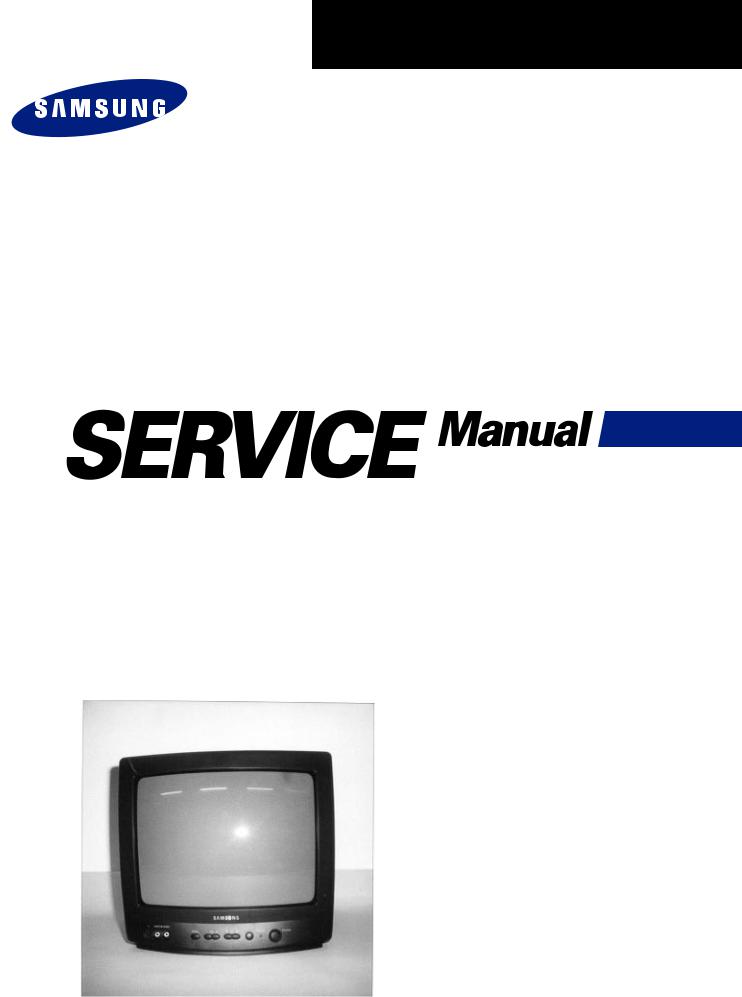
COLOR TELEVISION RECEIVER
Chassis : K15A
Model: TXJ1366
TXJ1367
TXJ1396
TXJ1966
TXJ1996
|
COLOR TELEVISION RECEIVER |
|
|
CONTENTS |
|
|
1. |
Precautions |
|
|
|
|||
|
|
|||
|
|
|||
|
|
|||
|
|
2. |
Specifications |
|
|
|
|||
|
|
|||
|
|
|||
|
|
|||
|
|
|||
|
|
|||
|
|
|||
|
|
|||
|
|
|||
|
|
3. |
Disassembly and Reassembly |
|
|
|
|||
|
|
|||
|
|
|||
|
|
|||
|
|
|||
|
|
|||
|
|
|||
|
|
|||
|
|
|||
|
|
|||
|
|
4. |
Alignment and Adjustments |
|
|
|
|||
|
|
|||
|
|
|||
|
|
|||
|
|
|||
|
|
|||
|
|
|||
|
|
|||
|
|
|||
|
|
5. |
Troubleshooting |
|
|
|
|||
|
|
|||
|
|
|||
|
|
|||
|
|
|||
|
|
|||
|
|
|||
|
|
|||
|
|
|||
|
|
6. |
Exploded Views and Parts List |
|
|
|
|||
|
|
|||
|
|
|||
|
|
|||
|
|
|||
|
|
|||
|
|
|||
|
|
|||
|
|
|||
|
|
7. |
Electric Parts List |
|
|
|
|||
|
|
|||
|
|
|||
|
|
|||
|
|
|||
|
|
|||
|
|
|||
|
|
|||
|
|
|||
|
|
|||
|
|
8. |
Block Diagram |
|
|
|
|||
|
|
|||
|
|
|||
|
|
|||
|
|
|||
|
|
|||
|
|
|||
|
|
|||
|
|
|||
|
|
9. |
PCB Layout |
|
|
|
|||
|
|
|||
|
|
|||
|
|
|||
|
|
|||
|
|
|||
|
|
|||
|
|
|||
|
|
|||
|
|
10. |
Wiring Diagrams |
|
|
|
|||
|
|
|||
|
|
|||
|
|
|||
|
|
|||
|
|
|||
|
|
|||
|
|
|||
|
|
|||
|
|
|||
|
|
11. |
Schematic Diagrams |
|
|
|
|||
|
|
|||
|
|
|||
|
|
|||
|
|
|||
|
|
|||
|
|
|||
|
|
|||
|
|
|
|
|
|
|
|
|
|

Precautions
1. Precautions
Follow these safety, servicing and ESD precautions to prevent damage and protect against potential hazards such as electrical shock and X-rays.
1-1 Safety Precautions
1.Be sure that all of the built-in protective devices are replaced. Restore any missing protective shields.
2.When reinstalling the chassis and its assemblies, be sure to restore all protective devices, including: nonmetallic control knobs and compartment covers.
3.Make sure that there are no cabinet openings through which people—particularly children—might insert fingers and contact dangerous voltages. Such openings include the spacing between the picture tube and the cabinet mask, excessively wide cabinet ventilation slots, and improperly fitted back covers.
If the measured resistance is less than 1.0 megohm or greater than 5.2 megohms, an abnormality exists that must be corrected before the unit is returned to the customer.
4.Leakage Current Hot Check (Figure 1-1): Warning: Do not use an isolation transformer during this test. Use a leakagecurrent tester or a metering system that complies with American National Standards Institute (ANIS C101.1, Leakage Current for Appliances), and Underwriters Laboratories (UL Publication UL1410, 59.7).
5.With the unit completely reassembled, plug the AC line cord directly into the power outlet. With the unit’s AC switch first in the ON position and then OFF, measure the current between a known earth ground (metal water pipe, conduit, etc.) and all exposed metal parts, including: antennas, handle brackets, metal cabinets, screwheads and control shafts. The current measured should not exceed 0.5 milliamp. Reverse the powerplug prongs in the AC outlet and repeat the test.
|
|
|
|
|
|
|
|
|
(READING SHOULD |
||
|
|
|
|
|
|
|
|
|
|||
|
|
|
|
|
|
LEAKAGE |
NOT BE ABOVE |
||||
DEVICE |
|
|
|
|
|
CURRENT |
|
0.5mA) |
|||
UNDER |
|
|
|
|
|
TESTER |
|
|
|
||
TEST |
|
|
|
|
|
|
|
|
|
|
|
|
|
|
|
|
|
|
|||||
|
|
TEST ALL |
|
|
|
|
|
|
|
||
|
EXPOSED METAL |
|
|
|
|
|
|
|
|||
|
|
SURFACES |
|
|
|
|
|
|
|
||
2-WIRE CORD |
|
|
|
|
|
|
|
||||
ALSO TEST WITH |
|
|
|
|
|
|
|
||||
PLUG REVERSED |
|
|
|
|
|
|
|
|
|||
(USING AC ADAPTER |
|
|
|
|
|
|
|
EARTH |
|||
PLUG AS REQUIRED) |
|
|
|
|
|
GROUND |
|||||
Fig. 1-1 AC Leakage Test
6.Antenna Cold Check:
With the unit’s AC plug disconnected from the AC source, connect an electrical jumper across the two AC prongs. Connect one lead of the ohmmeter to an AC prong. Connect the other lead to the coaxial connector.
7.X-ray Limits:
The picture tube is especially designed to prohibit X-ray emissions. To ensure continued X-ray protection, replace the picture tube only with one that is the same type as the original. Carefully reinstall the picture tube shields and mounting hardware; these also provide X-ray protection.
8.High Voltage Limits:
High voltage must be measured each time servicing is done on the B+, horizontal deflection or high voltage circuits. Correct operation of the X-ray protection circuits must be reconfirmed whenever they are serviced. (X-ray protection circuits also may be called “horizontal disable” or “hold-down”.)
Heed the high voltage limits. These include the X–ray Protection Specifications Label, and the Product Safety and X-ray Warning Note on the service data schematic.
Samsung Electronics |
1-1 |

Precautions
1-1 Safety Precautions (Continued)
9.High voltage is maintained within specified limits by close-tolerance, safety-related components and adjustments. If the high voltage exceeds the specified limits, check each of the special components.
10.Design Alteration Warning:
Never alter or add to the mechanical or electrical design of this unit. Example: Do not add auxiliary audio or video connectors. Such alterations might create a safety hazard. Also, any design changes or additions will void the manufacturer’s warranty.
11.Hot Chassis Warning:
Some TV receiver chassis are electrically connected directly to one conductor of the AC power cord. If an isolation transformer is not used, these units may be safely serviced only if the AC power plug is inserted so that the chassis is connected to the ground side of the AC source.
To confirm that the AC power plug is inserted correctly, do the following: Using an AC voltmeter, measure the voltage between the chassis and a known earth ground. If the reading is greater than 1.0V, remove the AC power plug, reverse its polarity and reinsert. Re-measure the voltage between the chassis and ground.
12.Some TV chassis are designed to operate with 85 volts AC between chassis and ground, regardless of the AC plug polarity. These units can be safely serviced only if an isolation transformer inserted between the receiver and the power source.
13.Some TV chassis have a secondary ground system in addition to the main chassis ground. This secondary ground system is not
isolated from the AC power line. The two ground systems are electrically separated by insulating material that must not be defeated or altered.
14.Components, parts and wiring that appear to have overheated or that are otherwise damaged should be replaced with parts that meet the original specifications. Always determine the cause of damage or overheating, and correct any potential hazards.
15.Observe the original lead dress, especially near the following areas: Antenna wiring, sharp edges, and especially the AC and high voltage power supplies. Always inspect for pinched, out-of-place, or frayed wiring. Do not change the spacing between components and the printed circuit board. Check the AC power cord for damage. Make sure that leads and components do not touch thermally hot parts.
16.Picture Tube Implosion Warning:
The picture tube in this receiver employs “integral implosion” protection. To ensure continued implosion protection, make sure that the replacement picture tube is the same as the original.
17.Do not remove, install or handle the picture tube without first putting on shatterproof goggles equipped with side shields. Never handle the picture tube by its neck. Some “in-line” picture tubes are equipped with a permanently attached deflection yoke; do not try to remove such “permanently attached” yokes from the picture tube.
18.Product Safety Notice:
Some electrical and mechanical parts have special safety-related characteristics which might not be obvious from visual inspection. These safety features and the protection they give might be lost if the replacement component differs from the original—even if the replacement is rated for higher voltage, wattage, etc.
Components that are critical for safety are indicated in the circuit diagram by shading,
(  ) or ( ! ).
) or ( ! ).
Use replacement components that have the same ratings, especially for flame resistance and dielectric strength specifications.
A replacement part that does not have the same safety characteristics as the original might create shock, fire or other hazards.
1-2 |
Samsung Electronics |

Precautions
1-2 Servicing Precautions
Warning1: First read the “Safety Precautions” section of this manual. If some unforeseen circumstance creates a conflict between the servicing and safety precautions, always follow the safety precautions.
Warning2: An electrolytic capacitor installed with the wrong polarity might explode.
1.Servicing precautions are printed on the cabinet. Follow them.
2.Always unplug the unit’s AC power cord from the AC power source before attempting to: (a) Remove or reinstall any component or assembly, (b) Disconnect an electrical plug or connector, (c) Connect a test component in parallel with an electrolytic capacitor.
3.Some components are raised above the printed circuit board for safety. An insulation tube or tape is sometimes used. The internal wiring is sometimes clamped to prevent contact with thermally hot components. Reinstall all such elements to their original position.
4.After servicing, always check that the screws, components and wiring have been correctly reinstalled. Make sure that the portion around the serviced part has not been damaged.
5.Check the insulation between the blades of the AC plug and accessible conductive parts (examples: metal panels, input terminals and earphone jacks).
6.Insulation Checking Procedure: Disconnect the power cord from the AC source and turn the power switch ON. Connect an insulation resistance meter (500V) to the blades of the AC plug.
The insulation resistance between each blade of the AC plug and accessible conductive parts (see above) should be greater than 1 megohm.
7.Never defeat any of the B+ voltage interlocks. Do not apply AC power to the unit (or any of its assemblies) unless all solid-state heat sinks are correctly installed.
8.Always connect a test instrument’s ground lead to the instrument chassis ground before connecting the positive lead; always remove the instrument’s ground lead last.
Samsung Electronics |
1-3 |

Precautions
1-3 Precautions for Electrostatically Sensitive Devices (ESDs)
1.Some semiconductor (“solid state”) devices are easily damaged by static electricity. Such components are called Electrostatically Sensitive Devices (ESDs); examples include integrated circuits and some field-effect transistors. The following techniques will reduce the occurrence of component damage caused by static electricity.
2.Immediately before handling any semicon ductor components or assemblies, drain the electrostatic charge from your body by touching a known earth ground. Alternatively, wear a discharging wrist-strap device. (Be sure to remove it prior to applying power— this is an electric shock precaution.)
3.After removing an ESD-equipped assembly, place it on a conductive surface such as aluminum foil to prevent accumulation of electrostatic charge.
4.Do not use freon-propelled chemicals. These can generate electrical charges that damage ESDs.
5.Use only a grounded-tip soldering iron when soldering or unsoldering ESDs.
6.Use only an anti-static solder removal device. Many solder removal devices are not rated as “anti-static”; these can accumulate sufficient electrical charge to damage ESDs.
7.Do not remove a replacement ESD from its protective package until you are ready to install it. Most replacement ESDs are packaged with leads that are electrically shorted together by conductive foam, aluminum foil or other conductive materials.
8.Immediately before removing the protective material from the leads of a replacement ESD, touch the protective material to the chassis or circuit assembly into which the device will be installed.
9.Minimize body motions when handling unpackaged replacement ESDs. Motions such as brushing clothes together, or lifting a foot from a carpeted floor can generate enough static electricity to damage an ESD.
1-4 |
Samsung Electronics |

ELECTRONICS
©Samsung Electronics Co., Ltd. SEP. 1999 Printed in Korea
3K15A-1425

Specifications
2. Specifications
2-1 Specifications
Television System |
14"/20"/21" NTSC COLOR TV SIGNAL |
|
|
Power Consumption |
14" : 57 WATTS NOMINAL, |
|
20" : 70 WATTS NOMINAL |
|
21" : 75 WATTS NOMINAL, |
|
|
Picture Tube |
14" : A34KQV42X |
|
20" : A48KRD82X (H) |
|
21": : A51KQJ63X (H) |
|
|
Power Requirement |
AC 120V, 60Hz /AC 100 ~ 240, 50Hz, 60Hz |
|
|
Operating System |
REMOCON SYSTEM (SZM354ET) |
|
|
Tuning Ranges |
VHF CH : 2-13, UHF CH : 14-69, CABLE CH : 1,14-125 |
|
|
Antenna Input Impedance |
75 ohm UNBALANCED TYPE FOR VHF/UHF |
|
|
Intermediate Frequency |
PICTURE 45.75MHz, SOUND 41.25MHz, |
|
COLOR SUB CARRIER 42.17MHz |
|
|
Speaker Impedance |
Single: 8 ohm 3W |
|
Dual : 8 ohm 3W x 2 |
|
Dual : 16 ohm , 3W x 2 (CT-33H1, CT-50H1) |
|
|
Samsung Electronics |
2-1 |
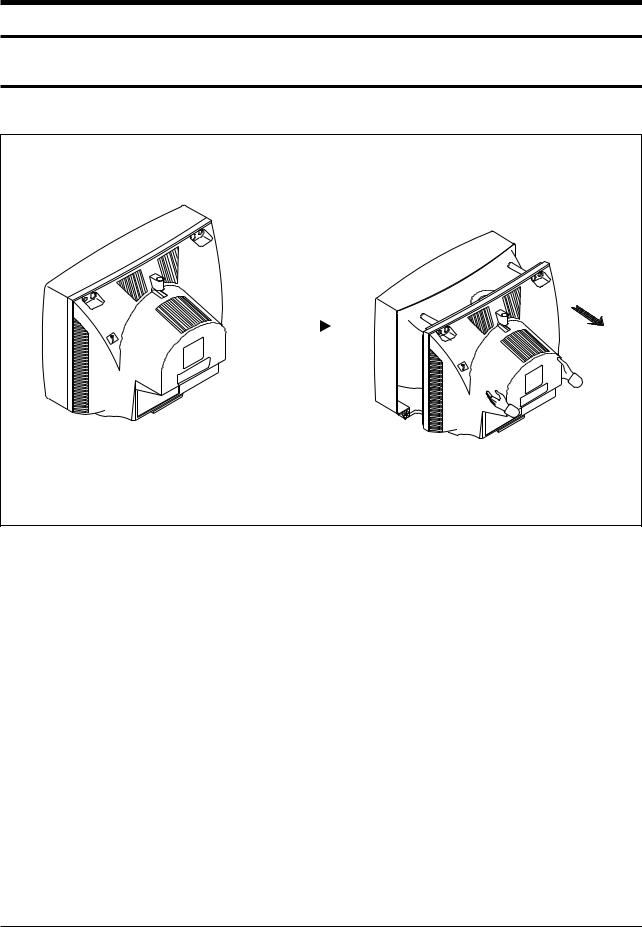
Disassembly and Reassembly
3. Disassembly and Reassembly
3-1 Back Cover Removeal
Fig. 3-1
1. After removing the screws, pull the cabinet backwards.
Samsung Electronics |
3-1 |
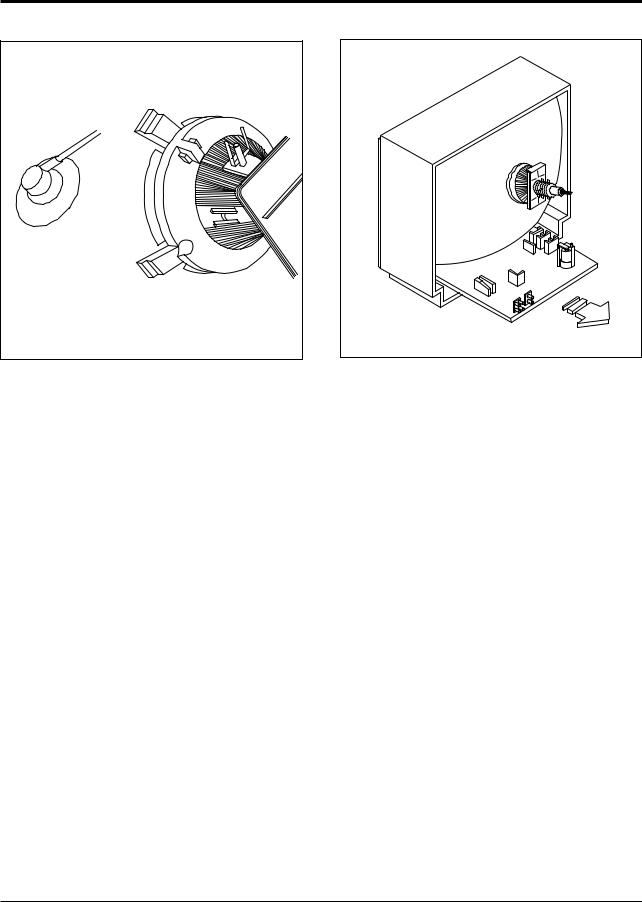
Disassembly and Reassembly
3-2 Main Board Removal
Fig. 3-2 |
Fig. 3-3 |
1.Separate the socket board from the CRT neck.
2.Remove the Anode Cap from the CRT.
3.Remove the main board by pulling it with both hands.
Warning: The FBT is charged with high voltage. Before removing the Anode Cap, discharge the voltage through one of the heat sinks on the main board.
3-2 |
Samsung Electronics |
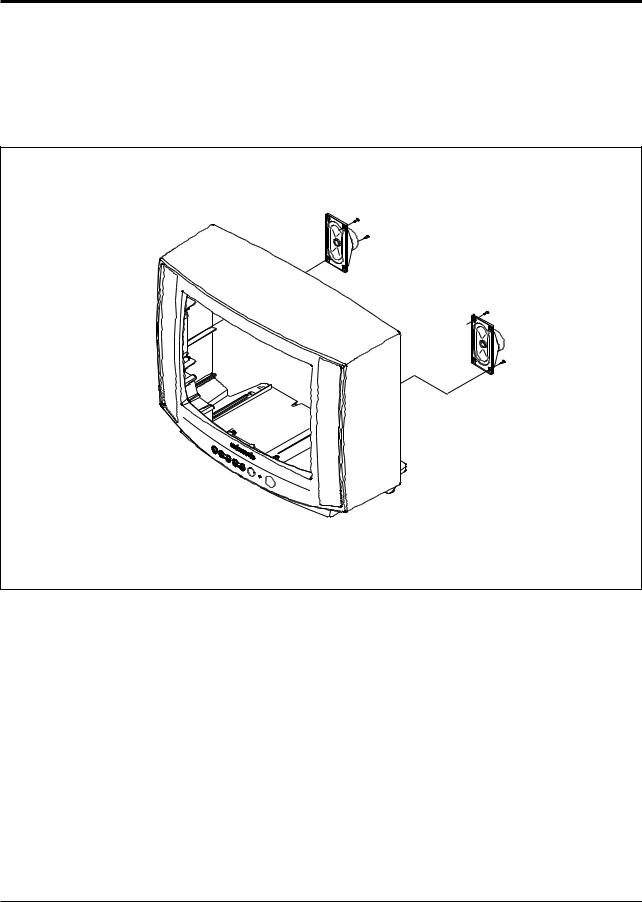
Disassembly and Reassembly
3-3 Speaker Removal
1. Loosen the screws and remove the speakers.
Fig. 3-4
Samsung Electronics |
3-3 |
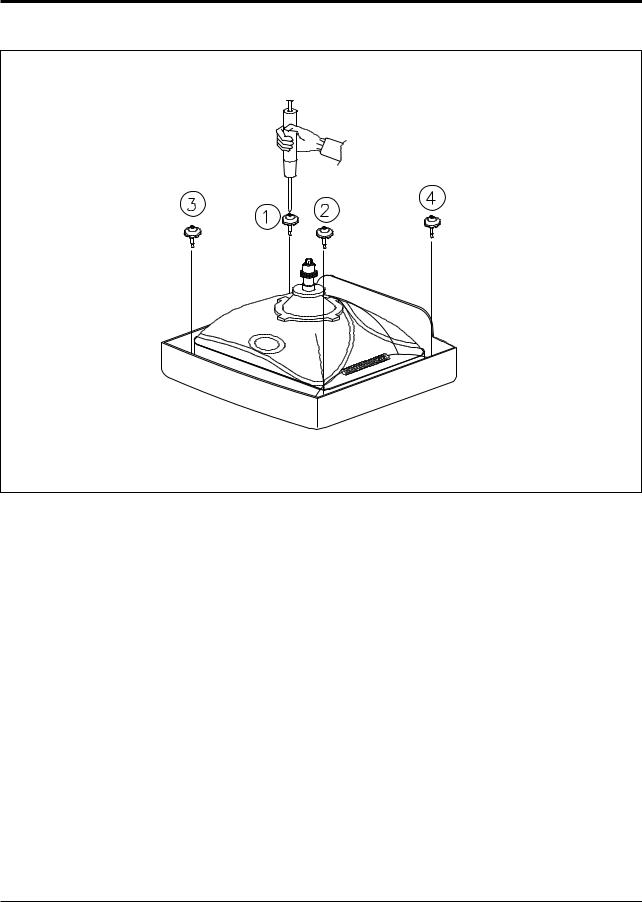
Disassembly and Reassembly
3-4 CRT Removel
Fig. 3-5
1.Spread a soft mat on the floor. Place the TV set face down.
2.Remove the 4 nuts mounting the CRT to the front cabinet.
3.Lift the CRT.
4.Caution: Because of the high vacuum and large surface area of the picture tube, be careful while handling it:
(1) Always lift the picture tube by grasping it firmly around the faceplate, (2) Never lift the tube by its neck. (3) Do not scratch the picture tube or apply excessive pressure. Fractures of the glass may cause an implosion.
3-4 |
Samsung Electronics |

Alignment and Adjustments
4. Alignment and Adjustments
4-1 Service Mode Adjustments
4-1-1 Service Mode Menus
Since there are no VRs in the K15A chassis, all adjustments after parts replacement must be done in the Service Mode. Service Mode adjustments are necessary when either the EEPROM (IC902) or the CRT is replaced.
4-1-2 Entering the Service Mode
Press the following transmitter keys while in STAND-BY mode:
MUTE—>1—>8—>2—>POWER “Factory Mode Menu” is displayed
|
|
|
< selected (violet) |
|
ADJUSTMENT |
|
|
|
PATTERN |
|
|
|
OPTION |
|
|
|
RESET |
|
|
|
|
|
|
Enter Service Mode using the Volume +,- keys. Service Mode Menu:
|
|
|
|
RC |
XXX |
|
AGC |
XX |
|
||
|
VCO |
XX |
GC |
XXX |
|
|
SBT |
XX |
BC |
XX |
|
|
SCT |
XX |
VA |
XX |
|
|
SCR |
XX |
VS |
XX |
|
|
STT |
XXX |
HS |
XX |
|
|
GG |
XXX |
SS |
XX |
|
|
BG |
XXX |
SVC : MUTE |
||
|
|
|
|
|
|
Select a mode to be adjusted, using the channel down key. Example: VCO.
|
|
|
|
|
|
|
AGC |
XX |
RC |
XXX |
|
|
|
|
GC |
XXX |
|
|
VCO |
XX |
|
||
|
SBT |
XX |
BC |
XX |
|
|
SCT |
XX |
VA |
XX |
|
|
SCR |
XX |
VS |
XX |
|
|
STT |
XXX |
HS |
XX |
|
|
GG |
XXX |
SS |
XX |
|
|
BG |
XXX |
SVC : MUTE |
|
|
|
|
|
|
|
|
Change the data with “Volume +, - “ keys.
VCO 71
Return to the Service mode by pressing MENU.
|
|
|
|
|
|
|
|
AGC |
XX |
RC |
XXX |
|
|
|
|
|
|
XXX |
|
|
|
VCO |
XX |
|
GC |
|
|
|
SBT |
XX |
BC |
XX |
|
|
|
SCT |
XX |
VA |
XX |
|
|
|
SCR |
XX |
VS |
XX |
|
|
|
STT |
XXX |
HS |
XX |
|
|
|
GG |
XXX |
SS |
XX |
|
|
|
BG |
XXX |
SVC : MUTE |
|
||
|
|
|
|
|
|
|
|
|
|
|
|
|
|
Return to the Factory mode via the MENU key.
ADJUSTMENT
PATTERN
OPTION
RESET
Press POWER to enter the Stand-by mode.
Samsung Electronics |
4-1 |
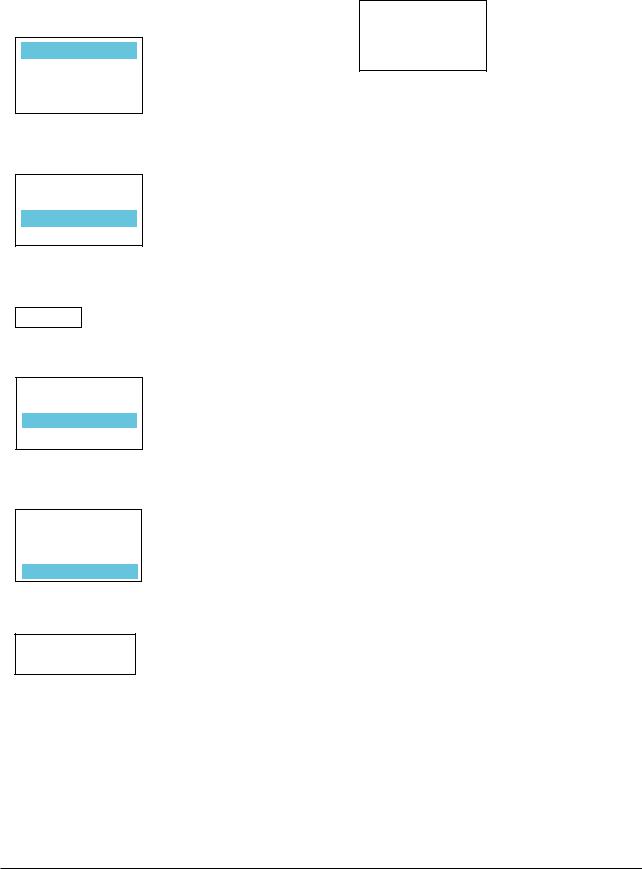
Alignment and Adjustments
4-1-3 Adjustment in Option Mode
This adjustment is necessary whenever the EEPROM is replaced. Input data (as marked on the back cabinet).
ADJUSTMENT
PATTERN
OPTION
RESET
Select “SET OPTION” by pressing the Channel ▼ key twice.
ADJUSTMENT
PATTERN
OPTION
RESET
Press the Volume +, - keys to enter the set Option mode.
BYTE 0 : 0 0
Press MENU to go back to the factory mode.
ADJUSTMENT
PATTERN
OPTION
RESET
Select RESET with channel ▼ key.
ADJUSTMENT
PATTERN
OPTION
RESET
Press volume + key.
POWER
OFF
4-1-4 Service Mode Adjustments
ADJUSTMENT
PATTERN
OPTION
RESET
1.The Pattern Adjustment is done only in the factory. Do not attempt to readjust it.
2.Refer to 4-2 for other adjustments.
3.Set OPTION data.
4-1-5 Service Mode Adjustment Ratings
No |
Item |
Function |
Range |
Initalized |
MICOM Data |
||||
|
|
|
|
|
1 |
AGC |
RF AGC Adjustment |
0~63 |
50 |
2 |
VCO |
PIF VCO Adjustment |
0~127 |
63 |
3 |
SCT |
SUB-CONTRAST Adjustment |
0~63 |
48 |
4 |
SCR |
SUB-COLOR Adjustment |
0~27 |
13 |
5 |
STT |
SUB-TINT Adjustment |
0~27 |
7 |
6 |
RC |
RED-CUT OFF Adjustment |
0~255 |
0 |
7 |
GC |
GREEN-CUT OFF Adjustment |
0~255 |
0 |
8 |
BC |
BLUE-CUT OFF Adjustment |
0~255 |
0 |
9 |
SVC |
Input a Horiz line pattern |
|
|
10 |
GG |
GREEN-GAIN Adjustment |
0~255 |
127 |
11 |
BG |
BLUE-GAIN Adjustment |
0~255 |
127 |
12 |
SBT |
SUB-BRIGHTNESS Adjustment |
0~63 |
31 |
13 |
VA |
VERTICAL SIZE Adjustment |
0~63 |
39 |
14 |
VS |
VERTICAL CENTER Adjustment |
0 |
0 |
15 |
HS |
HORIZONTAL Phase Adjustment |
0~31 |
15 |
16 |
SS |
SUB-SHARPNESS Adjustment |
0~31 |
4 |
|
|
|
|
|
Note : The initial MICOM data values take effect when IC902 is replaced.
4-2 |
Samsung Electronics |
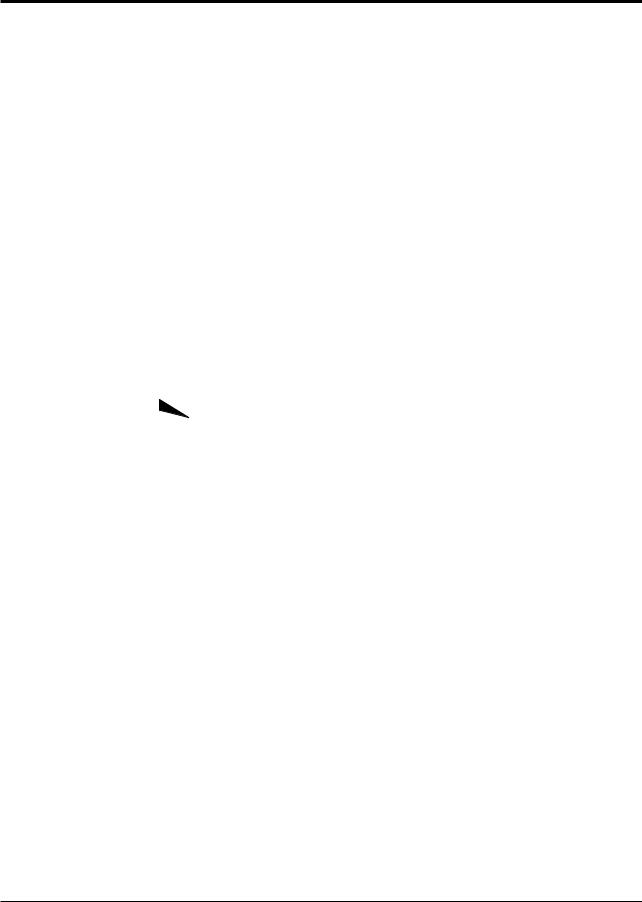
Alignment and Adjustments
4-2 Alignment and Adjustment
4-2-1 General Alignment Instructions
1.Usually, a color TV needs only slight touch-up adjustment upon installation. Check the basic characteristics such as picture height, focus and a horizontal and vertical sync.
2.Observe the picture and check for good back and white details. There should be no objectionable color shading: If color shading is present, demagnetize the receiver. If color shading persists, perform purity and convergence adjustments described below.
3.To protect against shock hazard, use an isolation transformer.
4-2-2 Power Supply Check
Check the following:
A:Power plug is connected; “Stand-by” mode
B:Power On when “Power ON” button is pressed
C:Power On by FBT Each supply is marked on
its lead-in wire. ( |
|
) |
4-2-5 IC902 Replacement
1.When IC902 is replaced, all values are reset to “Initialized MICOM Data” and readjustment is necessary.
2.Press the POWER button 10 seconds after plug-in.
3.To enter the Service Mode, refer to Fig. 4-1 (Service Mode Adjustment).
4-2-6 PIF VCO Adjustment
1.Use a Pattern Generator or an off-air signal.
2.Open pin 11 of Micom (IC901) or one side of lead pin for R237.
3.Adjust VCO in the service mode to set IC101 Pin 44 (AFT) to 2.5V ± 0.4V.
4.Connect the opened site.
4-2-3 Focus Adjustment
Adjust the focus control on the FBT for well defined scanning lines.
4-2-4 Fail Safe Circuit Check (FS) (OPTION)
1.The failsafe check must be the final step in servicing.
2.Turn the power switch ON and adjust customer controls for normal operation.
3.Temporarily short pin X to pin R on the main board (RX06, RX04) with a jumper wire. Raster will disappear.
4.The TV must remain in this state even after removing the jumper wire. This shows that the failsafe circuit is working properly.
5.To recover picture and sound, temporarily turn off the TV and allow the failsafe circuit more than 30 seconds to reset. Then switch power ON to produce normal picture and sound.
4-2-7 RF-AGC Adjustment
1.Input a PHILLIPS pattern.
2.Set the input signal to 60 dB.
3.Enter into the AGC in the service mode.
4.Adjust AGC until color bar noise disappears.
Samsung Electronics |
4-3 |
